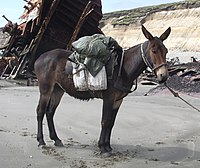
Photo from wikipedia
Water and nitrogen (N) are generally two of the most important factors in determining the crop productivity. Proper water and N managements are prerequisites for agriculture sustainable development in arid… Click to show full abstract
Water and nitrogen (N) are generally two of the most important factors in determining the crop productivity. Proper water and N managements are prerequisites for agriculture sustainable development in arid areas. Field experiments were conducted to study the responses of water productivity for crop yield (WPY-ET) and final biomass (WPB-ET) of film-mulched hybrid maize seed production to different irrigation and N treatments in the Hexi Corridor, Northwest China during April to September in 2013 and also during April to September in 2014. Three irrigation levels (70%–65%, 60%–55%, and 50%–45% of the field capacity) combined with three N rates (500, 400, and 300 kg N/hm2) were tested in 2013. The N treatments were adjusted to 500, 300, and 100 kg N/hm2 in 2014. Results showed that the responses of WPY-ET and WPB-ET to different irrigation amounts were different. WPY-ET was significantly reduced by lowering irrigation amounts while WPB-ET stayed relatively insensitive to irrigation amounts. However, WPY-ET and WPB-ET behaved consistently when subjected to different N treatments. There was a slight effect of reducing N input from 500 to 300 kg/hm2 on the WPY-ET and WPB-ET, however, when reducing N input to 100 kg/hm2, the values of WPY-ET and WPB-ET were significantly reduced. Water is the primary factor and N is the secondary factor in determining both yield (Y) and final biomass (B). Partial factor productivity from applied N (PFPN) was the maximum under the higher irrigation level and in lower N rate (100–300 kg N/hm2) in both years (2013 and 2014). Lowering the irrigation amount significantly reduced evapotranspiration (ET), but ET did not vary with different N rates (100–500 kg N/hm2). Both Y and B had robust linear relationships with ET, but the correlation between B and ET (R2=0.8588) was much better than that between Y and ET (R2=0.6062). When ET increased, WPY-ET linearly increased and WPB-ET decreased. Taking the indices of Y, B, WPY-ET, WPB-ET and PFPN into account, a higher irrigation level (70%–65% of the field capacity) and a lower N rate (100–300 kg N/hm2) are recommended to be a proper irrigation and N application strategy for plastic film-mulched hybrid maize seed production in arid Northwest China.
Journal Title: Journal of Arid Land
Year Published: 2017
Link to full text (if available)
Share on Social Media: Sign Up to like & get
recommendations!